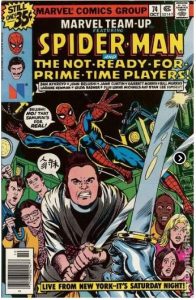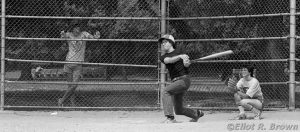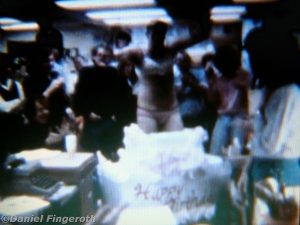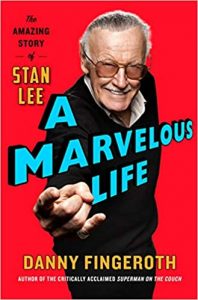by Nicholas Brown
Greetings from isolation!
It’s been a while since I’ve dropped an interview but this one is worth the wait, I assure you.
Today we host The Man, The Myth, The Editor, Danny Fingeroth!
He was the Editorial Director of Marvel’s various Spider-man titles back in the day and was the writer on several good titles, like Dazzler and Darkhawk. He is an old friend of Eliot’s from Marvel. They didn’t often work together, but as you’ll see, Danny’s got plenty of good dirt on him.
He’s the author of several books, the most recent of which is Stan Lee: A Marvelous Life, a wonderful biography of the man’s life which you should all go buy right now and there’s more information on that discussed below.
And these days Danny Fingeroth can be found working as a consultant to the Will Eisner Studios, and for the “Marvel: Universe of Super Heroes” Exhibition which is pretty damn cool.
He’s got such an impressive resume any brief descriptions I give barely scratch the surface so make sure you check out his website listed below.
And now I’ll let him take it away:
Q: What did you do before working at Marvel Comics and do you think that helped prepare you for the job?
It was my first real job after college. I was a film student/filmmaker. I had had a few film production assistant jobs and I thought it might be fun to work at Marvel Comics for a few months. I didn’t anticipate it would become my career. As far as my previous experience helping me with my job, well, I was a trained visual thinker, and had been a writer (and drawer) my entire life, so sure all that was very helpful in comics.
Q: What got you to get into the comic industry in the first place?
It seemed like a good way to avoid the real world. Sometimes that turned out to be true, sometimes not.
Q: What was the most fun you had working on a project at Marvel?
When I was head editor of the Spider-Man comics line (which had grown to close to twenty titles per month), it was fun to get together with the writers, artists and other editors in the group to brainstorm story ideas for the coming year. I would come in with my own plans, and I’d tell them: “Come up with something better, or you’ll be stuck with mine.”
Q: Do you have any stories from the Bullpen that you’d like to tell? Perhaps something Eliot has overlooked in his writings or that you’d like to add to.
Like when John Belushi and Paty Cockrum dueled samurai-style with t-squares in the Bullpen? Or when an unsecured ladder from a nearby construction site was buffeted by gale force winds and crashed through an office window during a birthday party, injured a Bullpenner, and startled us all? Or when legendary photographer Dith Pran took a photo of a bunch of us Bullpenners playing volleyball in Central Park on a freakishly warm February day, a photo that appeared on the front page of the New York Times? Nah, I got nothin’.
Q: John Belushi and Patty Cockrum dueling with T-Squares? Dad said it was something along the lines of Chris Claremont trying to do a crossover with SNL, would you mind relaying what exactly happened there? It sounds wild.
There was a comic of “Spider-Man Meets the Not Ready for Prime Time Players” in Marvel Team-Up #74:
I just recall people saying Belushi was there and we all gathered, and Paty had the idea of challenging him to a samurai duel, using T-squares as swords. She was very theatrical, so there was a lot of Samurai-inspired shouting from each of them. (Belushi often played an out-of-place samurai in various SNL sketches of the era–Samurai Deli Counter Man, etc., which was where the whole Samurai idea came from.) I would think the whole “duel” probably took less than a minute.
Not sure how that visit came about. But I would guess it was related to the crossover comic. There must have been comics fans at SNL, since they did at least one sketch that involved Marvel and DC superheroes at a party. I think Jim Shooter writes about Belushi’s visit in his blog.
[He did, in fact! The entry in question is here: http://jimshooter.com/2011/09/animal-house.html -N]
Q: Would you also mind elaborating on the ladder that came right through the window during a party? Eliot says that ended in a lawsuit and some new codes being put up which sounds great honestly.
That sounds right. It was totally weird, as you can imagine. During that period, there were regular (luckily phony) bomb scares in the building and at least one directed at Marvel in particular, so I’m sure that was in the back of everyone’s minds, too. The strange thing when something like that happens in real life is that, unlike in a movie, there’s no dramatic music leading up to or following such an event, so it can be very disorienting when something like that happens. Since it was in the middle of a birthday party (Mike Hobson’s 40th, I believe), in a way, we were expecting surprises to happen–but not a ladder crashing in and shattering glass and hurting someone.
Q: What’s your fondest off duty memory of the bullpen??
I enjoyed being on and, for a time, being co-captain of, the Marvel softball team, in the Publisher’s League. We played in Central Park’s Sheep Meadow in the days when (a) ball playing was allowed there, (b) it was made more of dried, sandy dirt than it was of grass, and (c) multiple games would literally cross over into each other, so that our infield was someone else’s outfield, and so on. In retrospect, it’s amazing to me that so many writers and artists, whose livelihoods depended on their hands, would risk their well-being by playing regularly in these games.
Q: What was your first impression of Eliot?
He seemed like an intelligent, affable, witty, creative fellow. And I was impressed that he lived around the corner from the office.
Q: Do you have any good embarrassing or funny stories about my father?
I guess it would have to be when he popped out of a giant-sized cardboard birthday cake (for Jim Shooter’s birthday?) dressed in a bikini. I’m not sure whose idea it was, maybe it was even his—pretty sure he constructed the cake—but it was hilarious and yet painful to watch that happen. Your dad would indeed do anything for a laugh.
Q: What has life been like after Marvel?
Never dull. I’ve broadened my areas of expertise, but pretty much everything I’ve done stems from some form of visual storytelling, which is what Marvel is all about. Plus, when you have “Marvel Comics” on your resume, people tend to notice, whether you want to emphasize it or not. So, on the one hand, that background has opened a lot of doors, but I think it sometimes makes people define your potential more narrowly than they should.
Q: Do you have a favorite story from your times attending Comic Cons? It’s a real shame they’ve had to be canceled this year.
One of my favorites is from the time I was moderating a Stan Lee panel at Wizard World in Sacramento in 2014. Stan was feeling under the weather and the president of Wizard told people that Stan (and I) would only be doing a twenty minute panel–instead of the regular 45—because Stan wasn’t feeling well. But as soon as we got on stage, I could see that being in front of a crowd energized Stan. At the twenty minute mark, I asked him if he had any parting words, since we were doing a short panel. He replied, “Is God talking to you? Did he say we have to stop? I feel great — let’s keep going!”
This response was completely unexpected, since he was pretty shaky before we got onstage. Everyone backstage—Wizard’s people and Stan’s handlers—went crazy, flashing me numerous hand signals that I had no idea what any of them meant. I had to improvise in a hurry.
We ended up doing another ten minutes and then the panel was over. But I’m sure Stan could have gone on for another couple of hours.
Q: Have you enjoyed seeing where Marvel has taken its characters in recent years? I’m referring specifically to the Marvel Cinematic Universe and its extended factions, but if you’ve kept up with Marvel Comics as well, I’m curious to hear your take.
It’s fun to see what Marvel has done with its movies and TV shows. Even at their sales peak, superhero comics were for a relatively niche market. Now, the characters and stories are everybody’s pop culture mythology. Sometimes I’ll see a story that I worked on as writer or editor turn up on screen, and that’s a strange feeling of déjà vu. I do miss, to some degree, that comics aren’t the “secret club” they used to be, but I think that’s overall a good thing.
Q: How have you been dealing with the quarantine situation these days? Any fun hobbies you’ve discovered or rediscovered?
I don’t know if I have any great quarantine stories. Mostly mixed boredom and anxiety like everybody else. I have discovered the digital book borrowing from the NY Public Library. Weird thing about it though is, when a book reaches its due date, it just disappears from your borrowed books, unlike a real-world borrowed library book where you can either renew or keep it longer and pay a small fee.
I have been doing a lot of zoom meetings and presentations, especially about my recent biography A MARVELOUS LIFE: THE AMAZING STORY OF STAN LEE (St. Martin’s Press/Macmillan). I also did the reading for the audio book version, which people might find interesting.
Q: Is there anywhere our readers can find you on social media to keep up with you?
My website is: www.dannyfingeroth.com. I’m also on facebook and twitter.
My recent, definitive biography of Stan Lee—A MARVELOUS LIFE: THE AMAZING STORY OF STAN LEE (St. Martin’s Press/Macmillan)—a prose book, not a comic—is available from all the usual suspects. My favorite blurb for the book is from the legendary Jules Feiffer (the credits ascribed to him are those he specified):
“There’s more about Stan Lee in this roller coaster of a book than I thought I’d ever want to know. But I couldn’t stop reading it. Danny Fingeroth gives us, page after page, rapid and cogent insights into the Marvel world, the comics universe, and Stan Lee as innovator, ring master, high-stakes gambler, con man, and an indefatigable charmer. And visionary, as well.”
—Jules Feiffer (assisted Will Eisner on The Spirit, and authored The Great Comic Book Heroes)
Aside from the print and digital versions of the book, there’s also a large type version. Plus, I read the audiobook, which is also widely available. (There’s a version floating around read by someone else, so make sure you get the one read by me.) For more on the book: https://us.macmillan.com/books/9781250133908
Nicholas here:
I absolutely loved these stories, Jim Belushi versus Patty Cockrum is an event that should go down in Marvel history if you ask me. It’s a shame it was before Eliot’s time, or we’d surely have pictures of the event, though Jim Shooter’s blog has some good group shots.
Danny has also written Superman on the Couch: What Superheroes Really Tell Us About Ourselves and Our Society and Disguised as Clark Kent: Jews, Comics, and the Creation of the Superhero .
During quarantine, I’ve been picking up one of my old favorites Grant Morrison’s run on Doom Patrol (Yeah, it’s DC, I know I know but I’m a comic fan first and a Marvel fan second) and trying to keep from losing my mind with some near success.
I hope you’re all staying safe and staying healthy out there.
Be like Spider-man and wear a mask!
Be seeing you
-Nicholas



